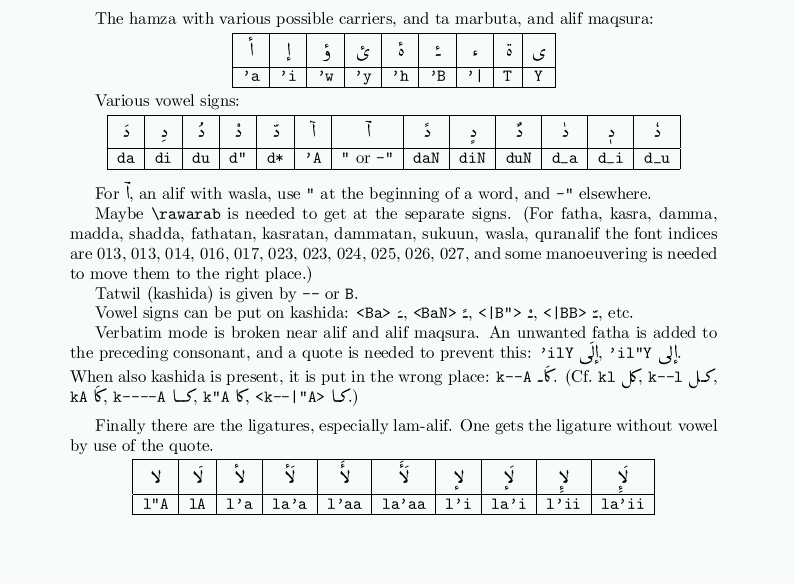Use of arabtex
ArabTeX is a very nice package for typesetting Arabic using TeX or LaTeX.
However, it is a little too smart, and working with it is like typing a
book on a typewriter that has its own opinions about spelling and sometimes
even about the subject matter of the book.
So, it is good that there is a verbatim mode that allows one to say
more precisely what one wants to see on paper.
Below some docs on this verbatim mode.
(If your browser does not render arabic, see LaTeX output
below.)
Verbatim mode is activated by \setverb and left again by
\setarab.
The 28 Arabic letters, together with the required ArabTeX input,
are given below.
| ا | ب | ت | ث | ج |
ح | خ | د | ذ | ر |
ز | س | ش | ص |
| A | b | t |
_t | j | .h |
_h | d | _d |
r | z | s |
^s | .s |
|
| ض | ط | ظ | ع | غ |
ف | ق | ك | ل | م |
ن | ه | و | ي |
| .d | .t | .z |
` | .g | f |
q | k | l |
m | n | h |
w | y |
A few foreign letters:
| پ | ڤ | چ | څ | ژ |
گ | ځ | ڭ | ڵ | ڕ |
| p | v | ^c |
,c | ^z | g |
c | ^n | ^l |
.r |
Verbatim mode will select the right letter shape
(isolated, initial, medial, final), e.g.,
<h hhh> yields ه ههه.
The font knows about two shapes for a medial h,  and
and  , but I do not know how to tell arabtex which
shape to use. Picking the glyph by hand does work: these two glyphs
can be obtained via \rawarab{352} and \rawarab{356}, after
\verb|\newcommand\rawarab[1]{{\fontencoding{U}\fontfamily{xnsh}\selectfont\char'#1\relax}}|
, but I do not know how to tell arabtex which
shape to use. Picking the glyph by hand does work: these two glyphs
can be obtained via \rawarab{352} and \rawarab{356}, after
\verb|\newcommand\rawarab[1]{{\fontencoding{U}\fontfamily{xnsh}\selectfont\char'#1\relax}}|
The hamza with various possible carriers, and ta marbuta,
and alif maqsura:
| أ | إ | ؤ | ئ | ۀ |
ـٔـ | ء | ة | ى |
| 'a | 'i | 'w | 'y | 'h | 'B | '| | T | Y |
Various vowel signs:
| دَ | دِ | دُ | دْ | دّ |
آ | ٱ | دً | دٍ | دٌ |
دٰ | دٖ | دٗ |
| da | di | du |
d" | d* | 'A |
" or -" | daN | diN |
duN | d_a | d_i |
d_u |
For ٱ, an alif with wasla, use " at the beginning
of a word, and -" elsewhere.
Maybe \rawarab is needed to get at the separate signs.
(For fatha, kasra, damma, madda, shadda, fathatan,
kasratan, dammatan, sukuun, wasla, quranalif the font indices are
013, 013, 014, 016, 017, 023, 023, 024, 025, 026, 027,
and some manoeuvering is needed to move them to the right place.)
Tatwil (kashida) is given by -- or B.
Vowel signs can be put on kashida:
<Ba> ـَـ,
<BaN> ـًـ,
<|B"> ـْـ,
<|BB> ـّـ, etc.
Bugs. Verbatim mode is broken near alif and alif maqsura.
An unwanted fatha is added to the preceding consonant,
and a quote is needed to prevent this:
<'ilY> إلَى, <'il"Y> إلى.
When also kashida is present, it is put in the wrong place:
<k--A> كَاـ.
Finally there are the ligatures, especially lam-alif.
One gets the ligature without vowel by use of the quote.
| لا | لَا | لأ | لَأ |
لأَ | لَأَ | لإ | لَإ |
لإِ | لَإِ |
| l"A | lA | l'a |
la'a | l'aa | la'aa |
l'i | la'i | l'ii |
la'ii |
Screenshots of the LaTeX output:


LaTeX source
 and
and  , but I do not know how to tell arabtex which
shape to use. Picking the glyph by hand does work: these two glyphs
can be obtained via \rawarab{352} and \rawarab{356}, after
\verb|\newcommand\rawarab[1]{{\fontencoding{U}\fontfamily{xnsh}\selectfont\char'#1\relax}}|
, but I do not know how to tell arabtex which
shape to use. Picking the glyph by hand does work: these two glyphs
can be obtained via \rawarab{352} and \rawarab{356}, after
\verb|\newcommand\rawarab[1]{{\fontencoding{U}\fontfamily{xnsh}\selectfont\char'#1\relax}}|

